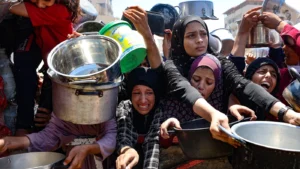In Gaza, bread is now a treasure and hunger a daily killer

Palestinians struggle to secure lentil soup at a food distribution point in Gaza City on 2 August 2025, as the World Health Organization warns that malnutrition is reaching ‘alarming levels’
Ahmed Dremly writes in Middle East Eye on 2 August 2025:
Since Israel launched its war on Gaza in October 2023, my family and I have remained near what was once our home in the north of the Strip.
Among the first regions cut off from aid and plunged into severe food shortages, we endured the initial painful period of starvation from November 2023 – just a month into the genocide – until a temporary truce in June 2024.
When the flour ran out, we resorted to baking bread from animal fodder and rancid white flour, just to survive. We lived on what little we had saved. We searched the destroyed homes of neighbours and relatives who had fled, sometimes finding a few cans of peas, chickpeas, fava beans or some flour left behind.
But all of that ran out in the early months. The war has now dragged on for more than 665 days, and everything has been taken from us.
As harrowing as that first wave of hunger was, the mass starvation we have endured since Israel broke the ceasefire on 18 March is far worse.
Daily hunger
Yesterday, like many others here, our family had nothing to eat. I woke up to the cries of my seven nieces and nephews, asking for food. The first thing I did was check my phone’s newsfeed, hoping – between the headlines and political noise – to find some sign of a genuine ceasefire, or at least the entry of food trucks.
Food is smuggled like gold. When a young man told me that 1kg of white flour costs 200 shekels ($60), I was not even shocked. Prices have lost all meaning here
The same hopeless reports day after day eat away at us. I asked my sisters if there was anything to eat, knowing it was a rhetorical question. We ask each other not just out of hunger, but to remind ourselves that food once existed, and that we used to have choices. The answer is always the same: a silent, grief-stricken smile.
I went out to search the streets of Gaza for anything I could afford to buy. After several hours, as I was returning empty-handed, I spotted a young man from afar, his clothes covered in flour dust. I recognised where he had come from: the so-called “Gaza Humanitarian Foundation” (GHF). He had flour – but he was hiding it, terrified of being robbed, not realising that his white shroud of dust was a dead giveaway of the treasure he clutched inside his shirt.
